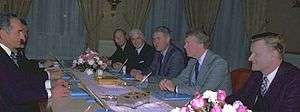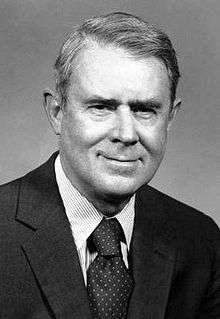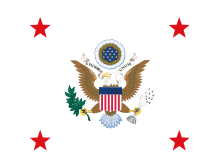Cyrus Vance
Cyrus Roberts Vance (March 27, 1917 – January 12, 2002) was an American lawyer and United States Secretary of State under President Jimmy Carter from 1977 to 1980.[1] Prior to that position he was the Secretary of the Army[2] and the Deputy Secretary of Defense.
As Secretary of State, Vance approached foreign policy with an emphasis on negotiation over conflict and a special interest in arms reduction. In April 1980, Vance resigned in protest of Operation Eagle Claw, the secret mission to rescue American hostages in Iran. He was succeeded in the position by Edmund Muskie.
Vance was the cousin (and adoptive son) of 1924 Democratic presidential candidate and lawyer John W. Davis.[3] He is the father of Manhattan District Attorney Cyrus Vance, Jr.
Early life and family
Vance was born on March 27, 1917, in Clarksburg, West Virginia.[4] He was the son of John Carl Vance II and his wife Amy Roberts Vance, and had an older brother, John Carl Vance III.[4][5] Following Vance's birth, his family relocated to Bronxville, New York, so that his father could commute to Manhattan, where he was an insurance broker.[6] Vance's father was also a landowner and worked for a government agency during World War I.[2] He died unexpectedly of pneumonia in 1922.[2] Vance's mother was Amy Roberts Vance, who had a prominent family history in Philadelphia and was active in civic affairs.[2] Following her husband's death, she moved her family to Switzerland for a year, where Vance and his brother learned French at L'Institut Sillig in Vevey.[6]
Vance's cousin John W. Davis, an Ambassador to the United Kingdom and 1924 United States presidential candidate, became his mentor and adopted him.[7]
Vance graduated from Kent School in 1935[2] and earned a bachelor's degree in 1939 from Yale University,[2] where he was a member of the secret society Scroll and Key. He also earned three varsity letters in ice hockey at Yale. He graduated from Yale Law School in 1942.[2]
Vance entered the US military during World War II, serving in the Navy as a gunnery officer on the destroyer USS Hale (DD-642) until 1946. Upon returning to civilian life he joined the law firm Simpson Thacher & Bartlett in New York City,[2] and later entered government services.
At the age of 29, Vance married Grace Elsie "Gay" Sloane on February 15, 1947. She was a Bryn Mawr College graduate and was the daughter of the board chairman of the W. & J. Sloane furniture company in New York City. They had five children:
- Elsie Nicoll Vance
- Amy Sloane Vance
- Grace Roberts Vance
- Camilla Vance Holmes
- Cyrus R. Vance, Jr.
Professional snowboarder Kevin Pearce is one of his grandsons.[8]
Political career
Vance was general counsel of the Defense Department and then the Secretary of the Army during the John F. Kennedy administration.[2] He was Secretary when Army units were sent to northern Mississippi in 1962 to protect James Meredith and ensure that the court-ordered integration of the University of Mississippi took place.[2]
As Deputy Secretary of Defense under President Lyndon Johnson, he first supported the Vietnam War but by the late 1960s changed his views and resigned from office, advising the President to pull out of South Vietnam. In 1968 he served as a delegate to peace talks in Paris.[2] He received the Presidential Medal of Freedom in 1969.[2] He was a professor at Georgetown University afterwards.

As Secretary of State in the Jimmy Carter administration, Vance pushed for negotiations and economic ties with the Soviet Union, and clashed frequently with the more hawkish National Security Advisor Zbigniew Brzezinski. Vance tried to advance arms limitations by working on the SALT II agreement with the Soviet Union, which he saw as the central diplomatic issue of the time. He was heavily instrumental in Carter's decision to return the Canal Zone to Panama, and in the Camp David Accords agreement between Israel and Egypt.
After the Camp David Accords, Vance's influence in the administration began to wane as Brzezinski's rose. His role in talks with People's Republic of China was marginalized, and his advice for a response to the Shah of Iran's collapsing regime was ignored. Shortly thereafter, when 53 American hostages were held in Iran, he worked actively in negotiations but to no avail. Finally, when Carter ordered a secret military rescue—Operation Eagle Claw—Vance resigned in opposition three days after the mission failed. Vance had correctly felt that the rescue attempt was too risky; a second rescue was planned but never carried out.

In 1997, he was made the original honorary chair of the American Iranian Council.[9]
Later career in law and as Special Envoy
In May 1970, Vance was appointed to served as a commissioner in a landmark panel known as the Knapp Commission, which was formed and tasked by New York City Mayor John V. Lindsay with investigating systemic corruption at the New York Police Department. The Knapp Commission held televised hearings into police corruption and issued a final report of its findings in 1972. The work of the Knapp Commission led to the prosecution of police officers on charges of corruption and culminated in significant, if short-lived, reforms and oversight in respect of the police department, including the appointment of a temporary special prosecutor to investigate and prosecute corruption committed by NYPD officers, district attorneys, and judges.
From 1974 to 1976, Vance served as president of the New York City Bar Association.[10] Vance returned to his law practice at Simpson Thacher & Bartlett in 1980, but was repeatedly called back to public service throughout the 1980s and 1990s, participating in diplomatic missions to Bosnia, Croatia, and South Africa.
In 1991, he was named Special Envoy of the Secretary-General of the United Nations for Croatia and proposed the Vance plan for solution of conflict in Croatia. Authorities of Croatia and Serbia agreed to Vance's plan, but the leaders of SAO Krajina rejected it, even though it offered Serbs quite a large degree of autonomy by the rest of the world's standards, as it did not include full independence for Krajina. He continued his work as member of Zagreb 4 group. The plan they drafted, named Z-4, was effectively superseded when Croatian forces retook the Krajina region (Operation Storm) in 1995.
In January 1993, as the United Nations Special Envoy to Bosnia, Vance and Lord David Owen, the EU representative, began negotiating a peace plan for the ending the War in Bosnia. The plan was rejected, and Vance announced his resignation as Special Envoy to the UN Secretary-General. He was replaced by Norwegian Foreign Minister Thorvald Stoltenberg.
Later life and death
In 1993, Vance was awarded the United States Military Academy's Sylvanus Thayer Award. In 1995 he again acted as Special Envoy of the Secretary-General of the United Nations and signed the interim accord as witness in the negotiations between the Republic of Macedonia and Greece. Vance was a member of the Trilateral Commission.
Vance died at the Mount Sinai Medical Center in New York City on January 12, 2002, at the age of 84, after a long battle with pneumonia, and the complication from Alzheimer's disease.[1] His remains were interred at the Arlington National Cemetery in Arlington, Virginia. Grace S. Vance died in New York City on March 22, 2008, at the age of 89.[11]
Legacy
In 1980, Vance received the U.S. Senator John Heinz Award for Greatest Public Service by an Elected or Appointed Official, an award given out annually by Jefferson Awards.[12]
In 1993 he received the Freedom medal.[13]
The house of Vance's mother, which was known as the Stealey-Goff-Vance House, was listed on the National Register of Historic Places in 1979.[14] It is home to the Harrison County Historical Society.[15]
In the 2012 movie Argo, Vance was portrayed by actor Bob Gunton.
See also
References
- 1 2 "Cyrus R. Vance, a Confidant Of Presidents, Is Dead at 84". New York Times. 13 January 2002. Retrieved 13 October 2012.
Cyrus R. Vance, who after two decades in public service was appointed secretary of state, and who then took the rare step of resigning from the nation's highest cabinet post on a matter of principle, died yesterday afternoon at Mount Sinai Medical Center in New York. He was 84. The cause was pneumonia and other complications, said Elva Murphy, his longtime secretary.
- 1 2 3 4 5 6 7 8 9 10 11 12 Bell, William Gardner (1992). ""Cyrus Roberts Vance"". Secretaries of War and Secretaries of the Army: Portraits and Biographical Sketches. United States Army Center of Military History. Retrieved September 22, 2007.
- ↑ "Cyrus was only 5 years old when his father died. In the ensuing years, the boy developed an exceptionally close relationship with his first cousin, best friend and mentor, John W. Davis, who had been a member of Congress, ambassador to Britain and Democratic candidate for president in 1924. It was through Mr. Davis that Mr. Vance said he developed an early interest in the law." (from his NYTimes obituary).
- 1 2 "Birth Record Detail: Cyrus Roberts Vance". West Virginia Vital Research Records. West Virginia Division of Culture and History. Retrieved August 10, 2015.
- ↑ "Birth Record Detail: John Carl III Vance". West Virginia Vital Research Records. West Virginia Division of Culture and History. Retrieved August 10, 2015.
- 1 2 Mihalkanin 2004, p. 512.
- ↑ Harbaugh 1973, pp. 389–390.
- ↑ http://worldblog.nbcnews.com/_news/2010/02/16/4377006-olympics-dreams-lost-but-pearce-stays-strong
- ↑ Khoda Hafez. "A Message from AIC on the Occasion of the New Year". American Iranian Council. Retrieved 20 September 2012.
- ↑ "The Legacy of Cyrus R. Vance". New York City Bar - Vance Center. Retrieved 20 September 2012.
- ↑ "Vance, Grace Sloane". The New York Times (Paid Notice: Deaths). March 26, 2008. Retrieved October 3, 2013.
- ↑ http://jeffersonawards.org/past%20winners
- ↑ Four Freedoms Award#Freedom Medal
- ↑ National Park Service (2010-07-09). "National Register Information System". National Register of Historic Places. National Park Service.
- ↑ Harrison County Historical Society Archived July 3, 2008, at the Wayback Machine.
Bibliography
- Harbaugh, William Henry (1973). Lawyer's Lawyer: The Life of John W. Davis. New York City: Oxford University Press. ISBN 9780195016994. OCLC 777309.
- Mihalkanin, Edward S. (2004). American Statesmen: Secretaries of State from John Jay to Colin Powell. Westport, Connecticut: Greenwood Publishing Group. ISBN 9780313308284. OCLC 57534433.
External links
| Wikimedia Commons has media related to Cyrus Vance. |
- Oral History Interviews with Cyrus Vance, from the Lyndon Baines Johnson Library
- Cyrus R. Vance and Grace Sloane Vance Papers, 1957-1992, held at Yale University Library, Manuscripts & Archives
- Cyrus Vance at Find a Grave
- Interview on French TV: Cartes sur table, 31 March 1980 (40 minutes)
| Political offices | ||
|---|---|---|
| Preceded by Elvis Jacob Stahr, Jr. |
U.S. Secretary of the Army Served under: John F. Kennedy, Lyndon Johnson July 1962 – January 1964 |
Succeeded by Stephen Ailes |
| Preceded by Roswell Gilpatric |
United States Deputy Secretary of Defense 1964–1967 |
Succeeded by Paul Nitze |
| Preceded by Henry Kissinger |
U.S. Secretary of State Served under: Jimmy Carter 1977–1980 |
Succeeded by Edmund Muskie |






